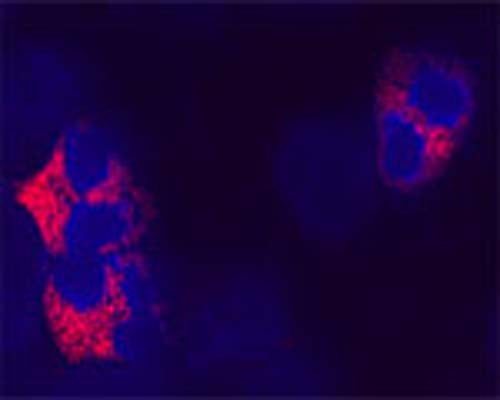Anti-Autophagy-related protein 7 (ATG7) Antibody
Our Anti-Autophagy-related protein 7 (ATG7) rabbit polyclonal primary antibody detects human and rat Autophagy-related protein 7 (ATG7), and is whole serum. It is validated for use in IHC-Frozen.



Confocal microscopy on cytospin-isolated human blood cells. Neutrophils seem to be stained using Rabbit antibody to ATG7: whole serum (R-161-100) at a dilution of 1: 100, incubated for 1 h at room temperature. The cells stained for ATG7 appear in red . The cells were counter stained with Hoechst Dye (blue colour). Here, the merged picture is presented.
Observations: No staining was observed using the Pre-immunisation serum. No staining was observed in HL60 cell line.
Click on image to zoom
Observations: No staining was observed using the Pre-immunisation serum. No staining was observed in HL60 cell line.
SKU: R-161-100
Ships: 1-2 business days
Product Details
Autophagy-related protein 7 (ATG7)
FUNCTION: Functions as an E1 enzyme essential for multisubstrates such as GABARAPL1 and ATG12. Forms intermediate conjugates with GABARAPL1 (GABARAPL2, GABARAP or MAP1ALC3). Formation of the final GABARAPL1-PE conjugate is essential for autophagy. SUBUNIT: Homodimer (By similarity). Interacts with ATG3 and ATG12. The complex, composed of ATG3 and ATG7, plays a role in the conjugation of ATG12 to ATG5. SUBCELLULAR LOCATION: Cytoplasm (Probable). ALTERNATIVE PRODUCTS: 2 named isoforms produced by alternative splicing. TISSUE SPECIFICITY: Widely expressed, especially in kidney, liver, lymph nodes and bone marrow. DOMAIN: The C-terminal part of the protein is essential for the dimerization and interaction with ATG3 and ATG12. SIMILARITY: Belongs to the ATG7 family. In yeast, ATG7 appears to be required for fusion of peroxisomal and vaculuolar membranes.
Whole serum
Polyclonal
Mixed
IHC, WB
Rabbit
A synthetic peptide (DSTRDRTLDQQC) corresponding to the C-terminal of human APG7 protein conjugated to blue carrier protein has been used as the immunogen. The peptide is homologous with the corresponding sequence derived from APG7 protein in mouse, rat, S. cerevisiae, Macaca mulatta (monkey) and Canis familiaris (dog).
Human
Human, Rat
Spin vial briefly before opening. Reconstitute in 100 µL sterile-filtered, ultrapure water. Centrifuge to remove any insoluble material. Store lyophilized antibody at 2-8°C. After reconstitution keep aliquots at -20°C for a higher stability, and at 2-8°C with an appropriate antibacterial agent. Glycerol (1:1) may be added for an additional stability. Avoid repetitive freeze/thaw cycles.
Lyophilized
WB: 1:100
IHC: 1:100
ICC: 1:100
IHC: 1:100
ICC: 1:100
Non-reduced Western blot : 1:100; IF: acetone or 3.7% PFA fixed cells (HJ Lim et al 2013); 1:100
Unconjugated
IF, WB and ELISA confirmed the specificity for ATG7. Human, rat. Other species not yet tested.
For research use only.
United States
12 months after date of receipt (unopened vial).
Autophagy-related protein 7; Ubiquitin-activating enzyme E1-like protein; hAGP7; APG7-like; ATG7; APG7L
25°C (ambient)


